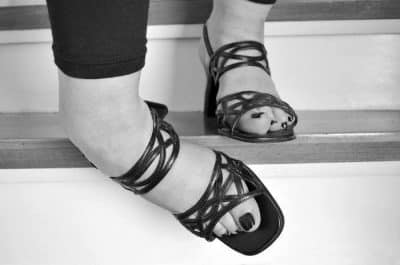According to the National Floor Safety Institute, slip and fall accidents are one of the most common reasons people end up in the emergency room and many times, these types of incidents can lead to costly liability claims. The most common causes of slip and fall injuries include poorly maintained sidewalks and public areas, loose handrails, and broken stairways. However, knowing what the most common risks are does not define the most likely outcome of a slip and fall incident.
What factors contribute to the type and amount of injury that a person has in such an incident? That’s what you need to keep in mind as a property owner.
What Determines Your Injuries?

The risks are there for slip and fall accidents. As a property owners consider what makes some accidents more detrimental than others. The Bureau of Labor Statistics says that five percent of all job-related fatalities for women are slip and fall accidents. Fractures are also the most serious consequence of falls and occur in about five percent of people.
Take a closer look at what are the common reasons why some types of falls are more problematic than others and what you may be able to do about them.
The Height Of The Fall
One of the key elements of risk involved in slip and fall accidents is just how high the fall was. Those falls that occur at more than 45 feet are the most likely to create significant damage to the body including internal organ damage and overall trauma.
However, falls that are under 30 feet, even those that are under 10 feet, are capable of producing musculoskeletal damage. This include slips and trips.
The Landing Position
Another key indication of the risk that occurs in slip and fall matters has to do with the way the person lands after such a fall. More specifically, whether or not protective reflexes helped to minimize the damage. This may include outstretching arms to break the fall.
In situations where the entire body hits the ground, the damage may be more spread out. If there is no protective reflex evidence in the fall, this could indicate that there was some type of neurological reason, such as impairment, that happened at the time of the slip and fall.
The Person’s Overall Health
Another key factor in slip and fall matters is the person’s overall well being. For example, if a person is older, overweight, larger in size overall, or not well, this will impact the damage he or she faces. Men, in some cases, face fewer risks and injuries because of their body composition. Some people are more likely to fall simply because they are older or have a weaker body frame than others. Additionally, those who are ill are more likely to have an immune system that does not allow for fast healing.
The Surface Area Impacted

It is also important to consider the surface area the person falls on and how that impacts a person’s overall ability to avoid injury. Specifically, consider the impact itself. How fast did the person fall? At what angle did he or she hit the ground? This also plays a role in the overall severity of the injuries the person sustained in the incident.
Slip and fall accidents occur for many reasons. However, some are much more damaging than others. As a property owner, it is up to you to ensure that the conditions are as good as possible to avoid liability matters, but in some cases, there is very little that can be done to avoid the outcome of such incidents.
